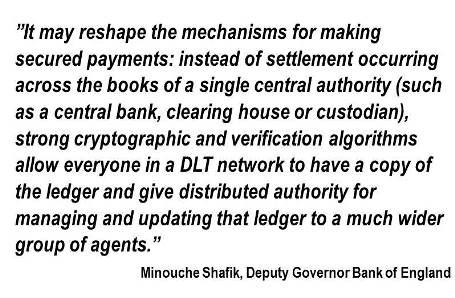 The Bank of England has indicated it will consider the impact of distributed ledgers as part of a plan to modernize the country’s settlement system.
The Bank of England has indicated it will consider the impact of distributed ledgers as part of a plan to modernize the country’s settlement system.
During a speech given at the Bank of England on January 28th 2016, Minouche Shafik, the central bank’s deputy governor for markets and banking, laid out a four-point vision for the initiative, which has the mandate to deliver goals by the end of this year, with technological development beginning in 2017.
The blueprint will seek to answer four questions, Shafik said. These include defining the bank’s policy objectives, determining what functions the payment system should have, establishing who should be able to access the system and electing the right role for the Bank of England to play in the service’s delivery.
As for distributed ledger technology (DLT), Shafik said that the innovation poses “profound challenges” due to its ability to decentralize the verification of payments, with a communal ledger serving the role of a traditional third party.
 Shafik said: ”It may reshape the mechanisms for making secured payments: instead of settlement occurring across the books of a single central authority (such as a central bank, clearing house or custodian), strong cryptographic and verification algorithms allow everyone in a DLT network to have a copy of the ledger and give distributed authority for managing and updating that ledger to a much wider group of agents.”
Shafik said: ”It may reshape the mechanisms for making secured payments: instead of settlement occurring across the books of a single central authority (such as a central bank, clearing house or custodian), strong cryptographic and verification algorithms allow everyone in a DLT network to have a copy of the ledger and give distributed authority for managing and updating that ledger to a much wider group of agents.”
Shafik continued by saying that DLT will be analyzed alongside other innovations such as electronic money, new methods of payments and machine learning.
Rooted in history: In statements, Shafik sought to position the project as one that was close to the Bank of England’s historical goals. Her remarks drew deeply from the history of the central bank, beginning with the story of why it emerged as a way to settle financial obligations between domestic institutions.
Also mentioned was how this mandate has been updated over time following the integration of new technologies, with an emphasis directed toward the real-time gross settlement system (RTGS) introduced in the mid-1990s.
“By allowing banks to settle high value transactions between each other, electronically, in real time, RTGS eliminated settlement risk on the largest payments flows – the ones most likely to threaten financial stability by bringing down the system if they failed,” Shafik said.
Given that the system is now 20 years old, Shafik said the time had come for the organization to reconsider how it would deliver on its mandate even as the pace of technological change accelerates.
Source: Coindesk.com























Trackbacks/Pingbacks